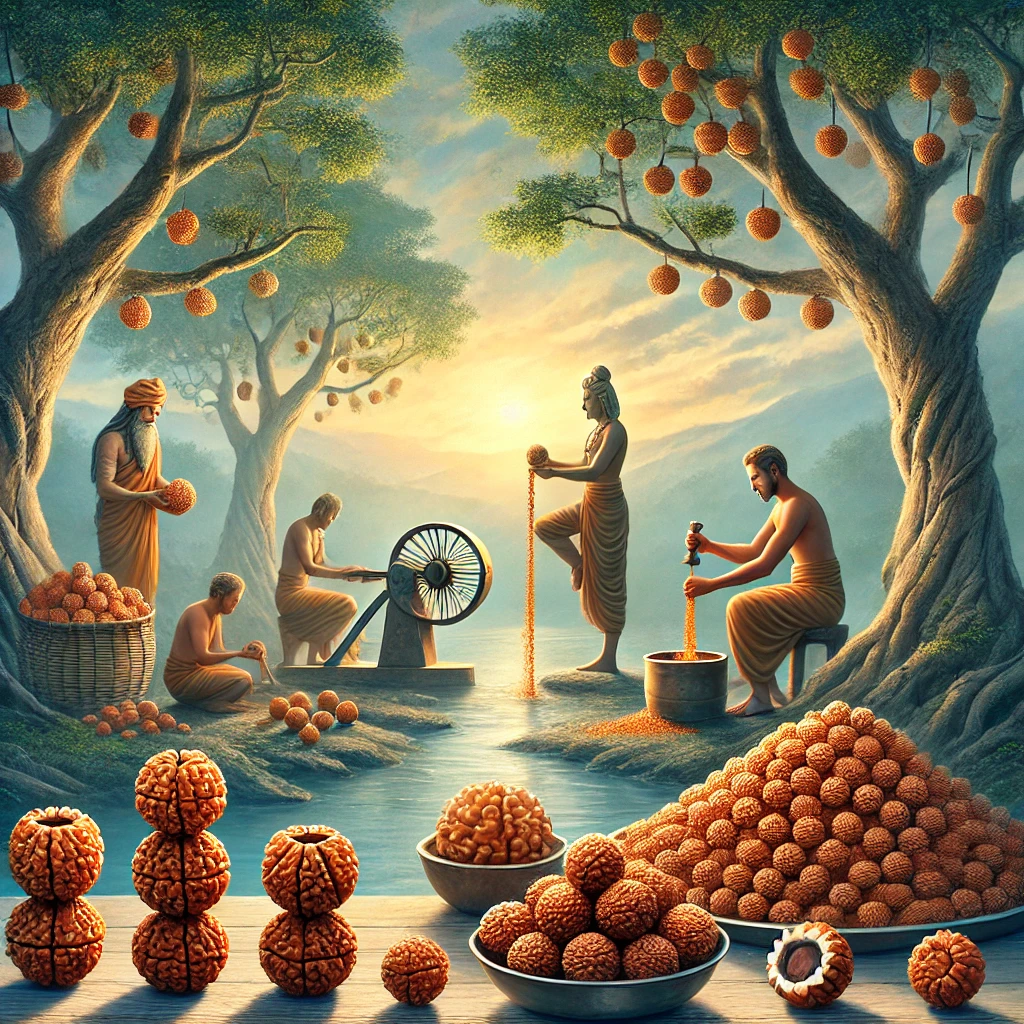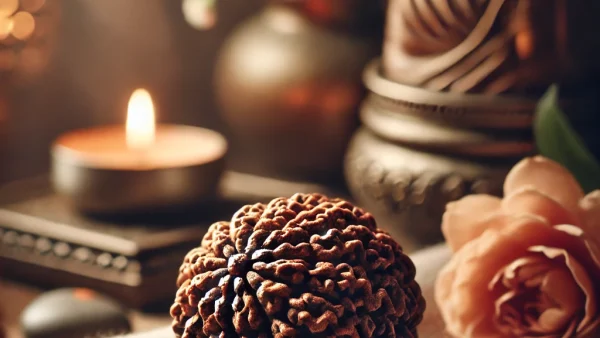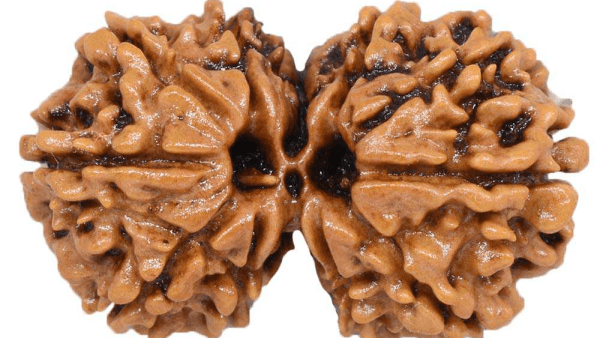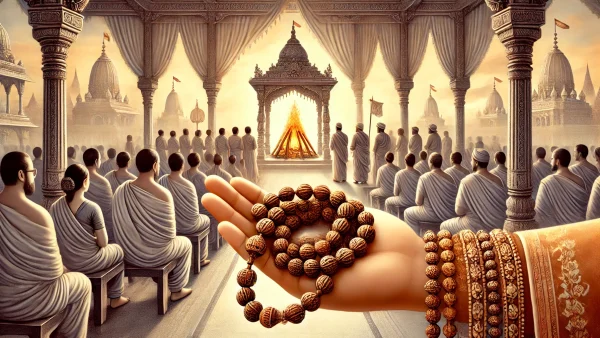Rudraksha beads have long been revered for their spiritual significance, particularly among followers of Hinduism and Lord Shiva devotees. These mystical beads are believed to hold divine energy, offering protection, mental clarity, and spiritual growth. But how are rudraksha beads made? From the raw fruit growing on ancient trees to the polished beads worn in malas, the process is intricate and deeply rooted in tradition. In this blog, we will explore the journey of rudraksha, shedding light on their origin, how they are processed, and why they remain a vital part of spiritual practices.
The Sacred Origin of Rudraksha
Before diving into the process of making rudraksha beads, it’s essential to understand their origin and connection to Lord Shiva. According to Hindu mythology, rudraksha beads are said to have emerged from the tears of Lord Shiva. The name itself comes from the Sanskrit words “Rudra” (a name for Shiva) and “Aksha” (meaning tears). When Lord Shiva meditated on the suffering of humanity, he shed a tear, which crystallized into rudraksha seeds upon touching the earth.
This mythical origin explains why rudraksha beads are so deeply connected to spirituality, meditation, and Shiva worship. These beads, particularly the highly regarded 5 Mukhi Rudraksha, are believed to embody the energy of Lord Shiva, bringing peace, health, and protection to the wearer.
Understanding the Rudraksha Tree
Rudraksha beads come from the seeds of the Elaeocarpus ganitrus tree, found predominantly in Nepal, India, Indonesia, and other parts of Southeast Asia. These trees are known to grow in mountainous regions, especially where the climate is moderate, with altitudes ranging from 500 to 2000 meters above sea level. A rudraksha tree begins bearing fruit after five to seven years, and it’s from these fruits that the rudraksha beads are derived.
The Harvesting of Rudraksha Fruits
The process of making rudraksha begins with the harvesting of the fruit. The rudraksha tree produces small, blue fruits that resemble blueberries. However, unlike the sweet berries you may be familiar with, these fruits are not edible. The fruit contains a large seed or kernel in the center, which is the actual rudraksha bead.
Harvesting usually takes place during the late autumn months when the fruits ripen and naturally fall from the tree. Farmers or gatherers collect these fruits and store them for further processing. The collection is typically a manual process, as the fruits are gently picked or gathered from the ground to ensure they remain intact.
The Transformation from Seed to Sacred Bead
1. Pulp Removal
Once the rudraksha fruits are harvested, the next step is to remove the outer pulp. This process can be done manually by soaking the fruits in water for several days to soften the pulp. After soaking, the pulp can be scrubbed away to reveal the rudraksha seed within. In more modern processing techniques, machines may be used to expedite this process, but traditional methods are still highly respected in spiritual communities.
Interestingly, the number of faces, or “mukhi,” of the rudraksha bead is only revealed once the pulp is removed. These faces are the natural lines that run along the surface of the bead, with each type of mukhi offering different spiritual benefits. The 5 Mukhi Rudraksha is the most commonly found and is highly revered for its association with peace and harmony.
2. Cleaning and Polishing
After the pulp is removed, the beads are thoroughly cleaned to eliminate any remaining residue. The raw seed is then polished to bring out its natural beauty and texture. The polishing can be done using natural oils or mechanical methods, depending on the desired finish.
In ancient times, rudraksha beads were polished using herbs and oils, believed to infuse the beads with additional healing properties. While modern processing may involve mechanical polishing, many spiritual practitioners still prefer beads polished with traditional oils for their authenticity and enhanced energy.
3. Drilling and Stringing
Once cleaned and polished, the beads aren’t drilled. They Get there Natural hole so they can be strung into malas, bracelets, or other forms of jewelry. The drilling process is delicate, as the rudraksha seed is fragile. Expert artisans often handle this step to ensure the integrity of the bead remains intact.
In malas, the number of beads typically follows sacred numbers, with 108 beads being the most common. The mala serves as a tool for meditation, where practitioners chant mantras like “Om Namah Shivaya” while counting each bead, allowing them to focus their mind on spiritual awakening.
Quality Grading of Rudraksha Beads
Not all rudraksha beads are the same, and they are graded based on their size, shape, and the number of faces. Each mukhi has a different meaning and spiritual benefit, and the rarity of the mukhi determines the bead’s value. For example, the 1 Mukhi Rudraksha is considered the rarest and most powerful, while the 5 Mukhi is more common but still holds immense spiritual value.
Types of Mukhi Rudraksha Beads:
- 1 Mukhi – Associated with enlightenment and connection to the Divine.
- 5 Mukhi – Known for promoting inner peace, and spiritual growth, and is commonly used in meditation.
- 7 Mukhi – Linked to prosperity and wealth.
- 14 Mukhi – Said to open the third eye chakra, heightening intuition and spiritual awareness.
The Spiritual Importance of Rudraksha
Wearing a rudraksha bead, especially one of high quality, is considered to bring many benefits. According to Hindu tradition, each rudraksha bead carries the vibration of Lord Shiva, offering protection, reducing stress, and promoting mental clarity. Many believe that wearing a 5 Mukhi Rudraksha, for example, helps balance the chakras and brings peace to the mind and body.
Devotees of Lord Shiva often wear rudraksha beads as part of their spiritual practice. The beads are used in meditation, prayer, and during various rituals, enhancing the connection to the divine. Rudraksha malas are often worn by spiritual seekers, yogis, and sages who have devoted their lives to self-realization and enlightenment.
How to Identify Authentic Rudraksha Beads
With the growing popularity of rudraksha beads, it’s important to ensure the authenticity of the beads you purchase. Authentic rudraksha beads can be identified through a variety of tests:
- Water Test: Authentic rudraksha beads tend to sink in water, whereas fake ones might float.
- Magnetic Test: Real beads do not have magnetic properties, so if a bead is magnetic, it’s likely to be fake.
When purchasing rudraksha beads, it’s crucial to buy them from a trusted source to ensure their authenticity and spiritual efficacy.
Final Thoughts: The Sacred Journey of Rudraksha
From the moment the fruit falls from the tree to the final stage of stringing the beads, the journey of rudraksha is one that is deeply spiritual and sacred. Whether you are a follower of Hinduism or a devotee of Lord Shiva, understanding how rudraksha beads are made deepens your appreciation for their power and symbolism.
If you’re looking to enhance your spiritual practice, explore our range of authentic rudraksha malas and spiritual accessories at spiritualguru.lk. Our carefully curated collection includes various types of rudraksha beads, from the popular 5 Mukhi Rudraksha to rare and powerful varieties, all designed to support your journey toward spiritual awakening.







Pingback: Can Rudraksha Be Worn by Women? - Spiritual Guru
Pingback: Benefits Of 10 Mukhi Rudraksha - Spiritual Guru